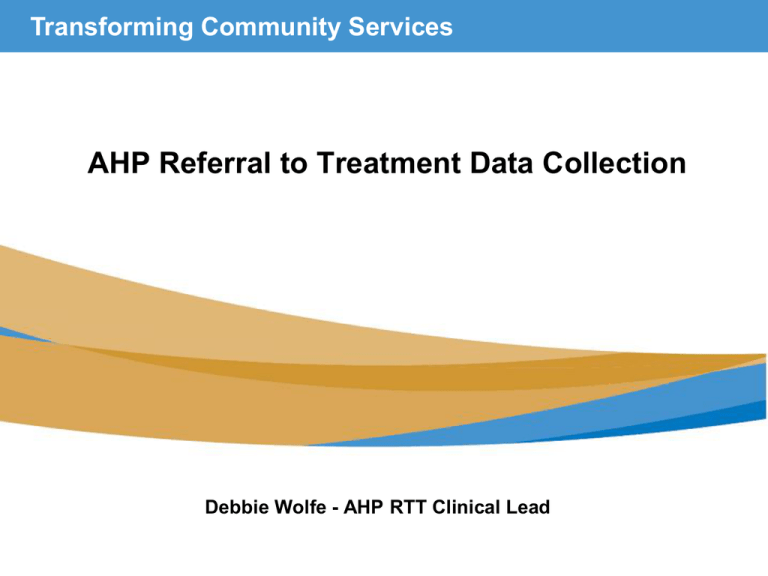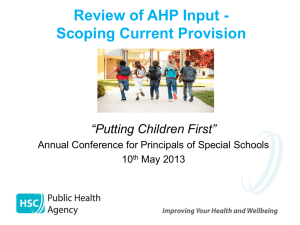AHP Referral to Treatment Data Collection
advertisement

Transforming Community Services AHP Referral to Treatment Data Collection Debbie Wolfe - AHP RTT Clinical Lead Transforming Community Services AHP Referral to Treatment data collection • Developed to deliver the commitments in: ‘Framing the contribution of Allied Health Professionals’ (DH, 2008) The NHS Operating Framework 2009/10 and 2010/11 • A framework to make clinically sound decisions for clock start and stops to measure waiting times • Underlying principle that patients should receive excellent care without unnecessary delay Transforming Community Services Aim of AHP RTT • 11 AHPs mandated to collect and report AHP RTT data from April 2011subject to ISB and ROCR approval • Enable services to understand their waiting times • Improve ease of access to AHP services for patients • Initiate quality, innovation and productivity • Links with AHP Professional Leadership Team’s Service Improvement Programme Transforming Community Services • 11 pilot sites involved in developing the rules • Voluntary collection from April 2010 • No national target attached to RTT pathway • Relevant to AHPs delivering NHS funded non-medical consultant led services • Data collection for treatment as part of a medical consultant led service contributes to national 18-week pathway Transforming Community Services Clock start • The referral to treatment clock starts on the date the referral is received by the service or UBRN converted • Referral can be from any agreed source including selfreferral • When a date is arranged to treat following active monitoring • Patient rebooks appointment following DNA of first appointment Transforming Community Services Clock stop for treatment • First definitive treatment provided Assessment when no further intervention required Assessment and treatment Advice Fitting of medical device Delivery of equipment Transforming Community Services Clock stop for ‘non-treatment’ • Decision not to treat • Start a period of active monitoring • Return patient to GP for referral to a medical consultant • Patient declines treatment • Patient died before treatment Transforming Community Services DNAs First appointment: • Discharge • Nullified clocks Follow up appointment prior to first definitive treatment: • Discharge • Earliest Clinically Appropriate Date • Earliest Reasonable Offer Date Transforming Community Services What can we do to prepare for April 2011? • Training staff re: clock starts and stops • Discuss a local target for AHP RTT waiting times • Review your Local Access Policy • Unpick complex service provision • Test ability to collect and report clock starts and stops locally • Support available through 2010 Transforming Community Services Flow of AHP RTT Clock Rules Referral made to AHP service Referral received by AHP service or UBRN converted CLOCK START Appointment communicated to patient Patient DNAs first appointment Patient is discharged or the clock is nullified (dependent on local access policy) Patient returns for first definitive treatment Patient attends first appointment, receives assessment but not first definitive treatment. Follow up appointment made to return for treatment CLOCK STOP Patient DNAs appointment. Clock keeps ticking Active monitoring Discharge (dependent on local access policy) Patient attends for assessment and first definitive treatment (clinical intervention, advice) Patient cancels first appointment (clock keeps ticking) CLOCK STOP Transforming Community Services AHP RTT guide available on: www.dh.gov.uk/en/Healthcare/Primarycare/TCS deborah.wolfe@dh.gsi.gov.uk Thank you Questions and discussion








![3. DM LunchPresentation[90 min. PPT]](http://s2.studylib.net/store/data/005799668_1-1ec7de34d5a9fb2babd38a65fa8355f0-300x300.png)
